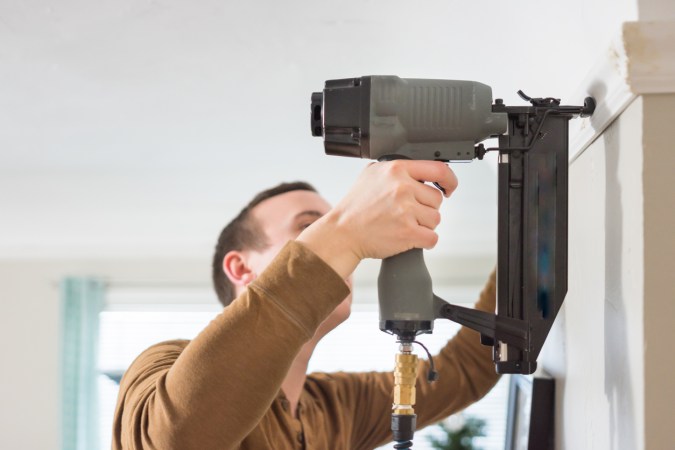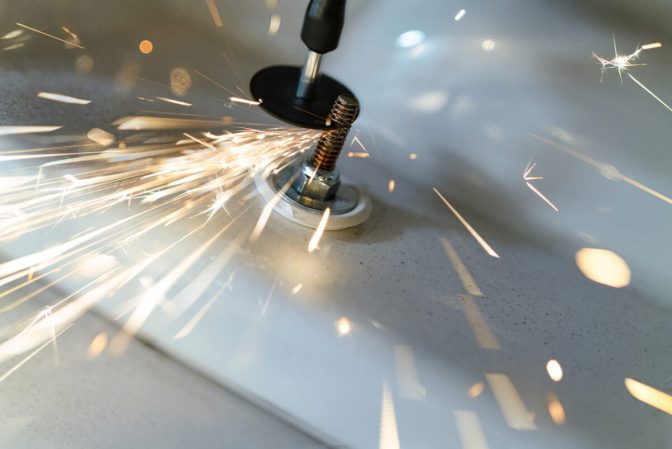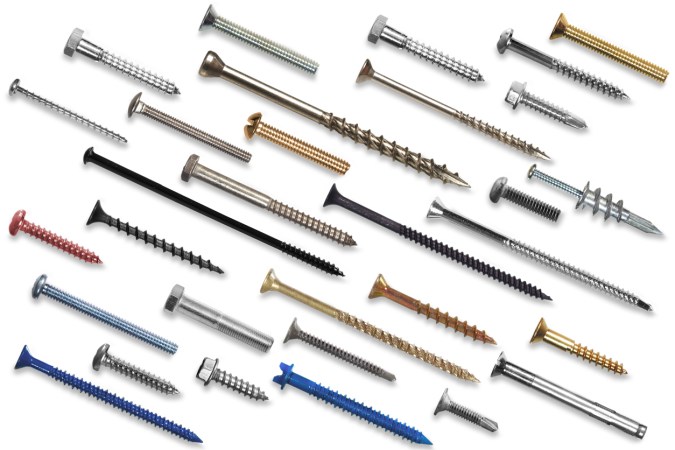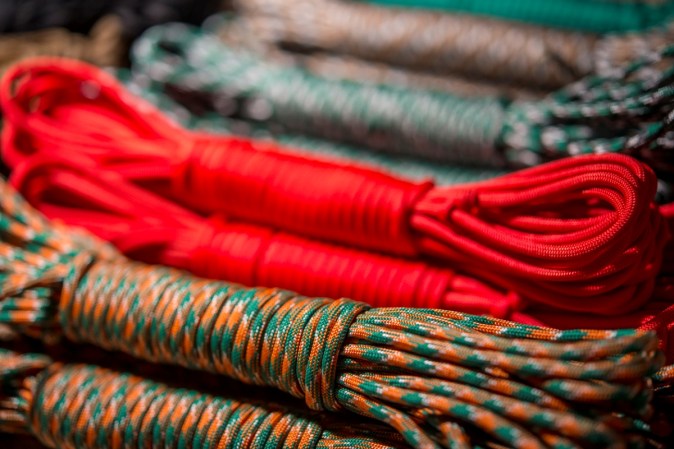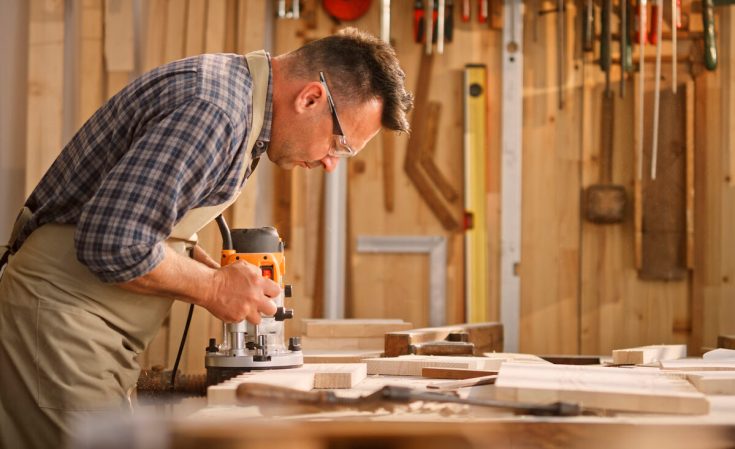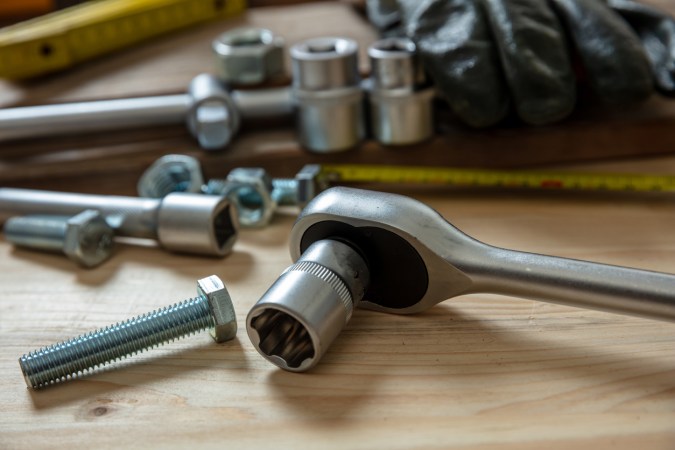We may earn revenue from the products available on this page and participate in affiliate programs. Learn More ›
“If the only tool you have is a hammer, it is tempting to treat everything as if it were a nail,” wrote Abraham Maslow. While this timeless quote has more to do with solving problems than it does hardware nails, we like to think that it’s also a nod to the multitude of types of nails available (at least for this article’s sake!). Each with its different function and purpose, there are more than 20 nail types that DIYers and pros might run into. For example, installing trim and molding calls for finishing nails, while a new roof needs a—you guessed it—roofing nail.
This guide will explain some of the most common (and some specialized) nail types DIYers might run into. From light-duty to heavy-duty and big to small, keep reading to learn more about 25 nail types and the applications for each type.
Parts of a Nail
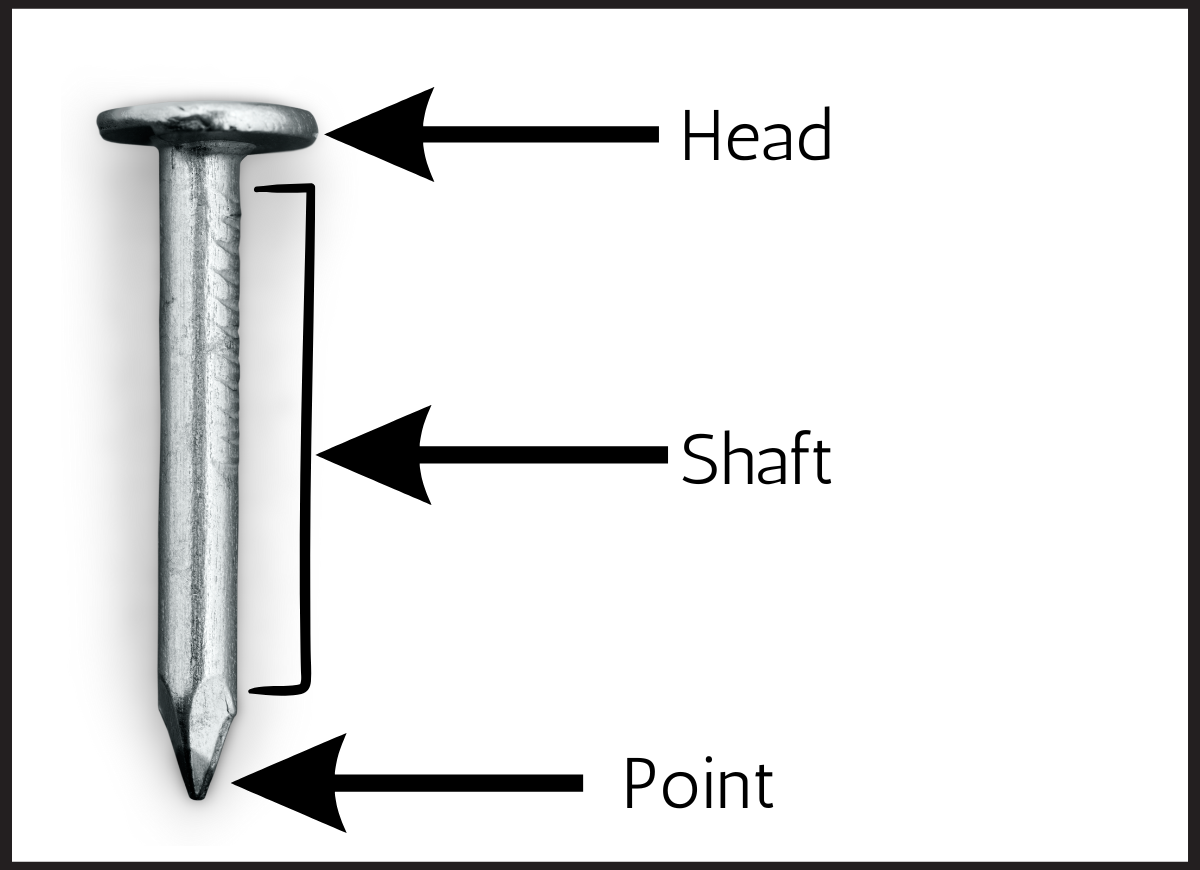
In most cases, there are three main parts of a nail. These three parts include the head, the shank, and the point. Each of these parts serves a purpose.
- The head of a nail is the flat surface on the rear of the nail that the user strikes with a hammer. The head serves two purposes: It acts as a striking surface for driving the nail but also acts as more surface area for pinning the material in place. There are several types of nail heads, including flat, countersink, checkered, and more.
- The shank is the long, thin section of the nail that stretches from the head to the point. This section is usually cylindrical, but many nails have specialized shanks that provide them with specific capabilities.
- The point is the section of the nail that penetrates the wood. On the surface, points look conical, but most actually consist of flat sections. This helps the nail act as a wedge, splitting the fibers apart as the user drives it. Conversely, some nails have blunted tips, and they punch the fibers forward as the user drives the nail rather than wedging, and this makes blunted tips less likely to split wood.
Nail Size Chart
The D in nail sizes indicates “penny,” and they’re pronounced as such: 10D is pronounced “ten-penny.” Originally, the term indicated how many pennies a carpenter would have to pay for 100 nails of a specific length. The longer the length, the more pennies they’d have to pay for the lot.
For example, 100 nails that are 3½ inches long would cost the carpenter 16 pennies, so those nails were called “sixteen-penny” nails. Even if the carpenter were only buying 30, they would say “Can I please have 30 sixteen-penny nails?”
| Size | Length |
| 2D | 1 inch |
| 3D | 1¼ inches |
| 4D | 1½ inches |
| 5D | 1¾ inches |
| 6D | 2 inches |
| 8D | 2½ inches |
| 10D | 3 inches |
| 12D | 3¼ inches |
| 16D | 3½ inches |
| 20D | 4 inches |
| 30D | 4½ inches |
| 60D | 6 inches |
The penny system is primarily used for nails for wood framing, such as sinkers, common nails, and box nails. And despite the clear and reasonable preference for nail guns, most framing carpenters often carry three nail sizes, and they are 8D, 10D, and 16D.
The typical use for an 8D nail is attaching a wall plate to the subfloor. Since they’re cheaper, they’re also commonly used for attaching chalk lines to sheet goods or to act as hinges when lifting framed wall assemblies. They can also attach furring strips, sheathing, and other thinner materials.
Ten-penny (10D) nails are typically used for building header assemblies and framing walls. Their 3-inch length means they can punch through two 2x6s, 2x8s, or 2x10s with a ½-inch piece of plywood between them (a header sandwich) without poking through the other side. They may also be used for non-loadbearing walls.
The 16D nail is the workhorse of the framing crew. These nails are long and strong, and they’re used for actual wall assemblies. The carpenter nails through the face of the top and bottom plates and into the ends of the individual wall studs, pinning them in place as a wall assembly. These nails provide enough holding power while also allowing the walls to rack and adjust a bit over time without breaking.
RELATED: Buyer’s Guide: The Best Palm Nailers
Nail Materials and Finishes
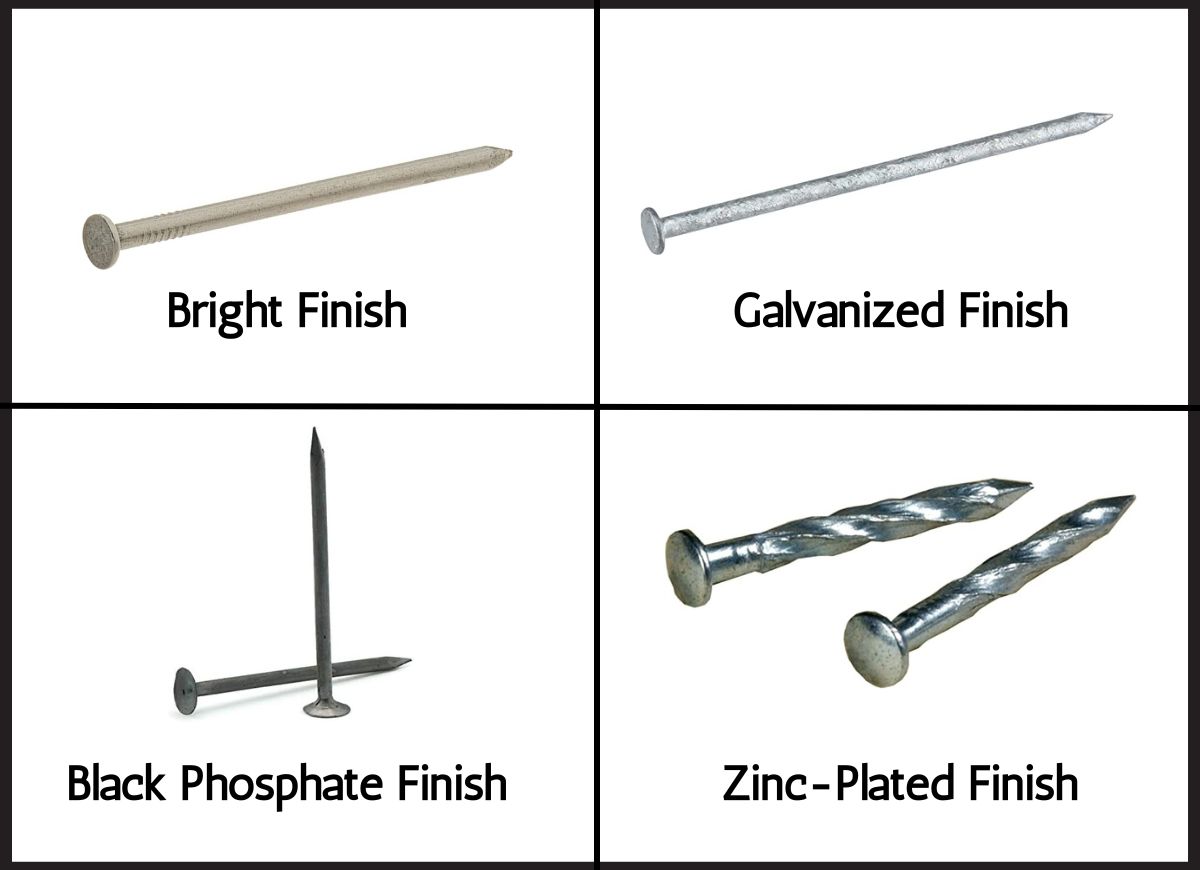
As far as materials go, most kinds of nails are steel. However, there are also nails in materials such as stainless steel, copper, iron, aluminum, or bronze. Stainless steel nails are useful since they don’t react with materials like cedar or redwood. Copper nails are useful when installing copper flashing or copper ceiling tiles. Iron nails are from years gone by, but some DIYers and craftspeople use them in their projects for a vintage flare.
Believe it or not, there are many types of nail finishes as well. Most of the time, the finish either affects the way the nail sinks into the wood or how corrosion-resistant the nail is. Common nail finishes include:
- Bright: Unfinished, raw metal
- Galvanized: Dipped in a corrosion-resistant coating
- Black phosphate: A thin layer of protection that promotes paint adhesion
- Zinc-plated: A thin coating of zinc that works best indoors, and it typically looks silver or gold in color but adds corrosion resistance
General Nails
One walk down the fasteners aisle at a big box home improvement store will prove that nail varieties abound. However, some nails are more common than others, and this guide will break down some of the different types of nails.
Note: Some of these building nails do overlap, as there is often more than one name used for an item on a construction site.
1. Common Nail
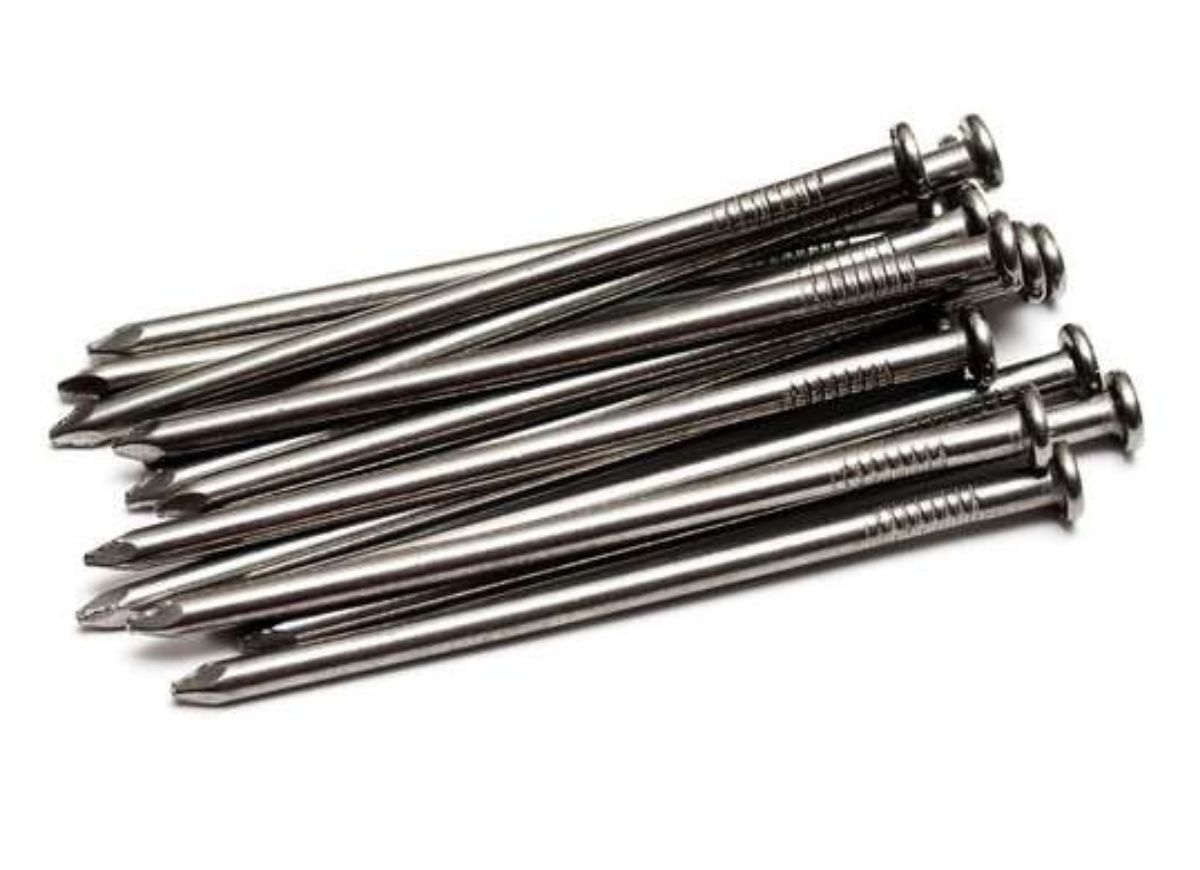
As the name suggests, common nails are your everyday nails. They are generally used for rough construction work, and can be driven into hard materials. They typically have a bright finish, which means they won’t last long in outdoor applications.
Best For: Framing and general construction work that isn’t exposed to weather
2. Box Nail

These look like common nails, but they are thinner. This means they are less likely to cause splits in the wood but they also have less holding power. So, if structural strength is critical, avoid box nails.
Best For: General construction, but they don’t have the strength of a common nail
RELATED: How to Use a Nail Gun
3. Duplex Nail
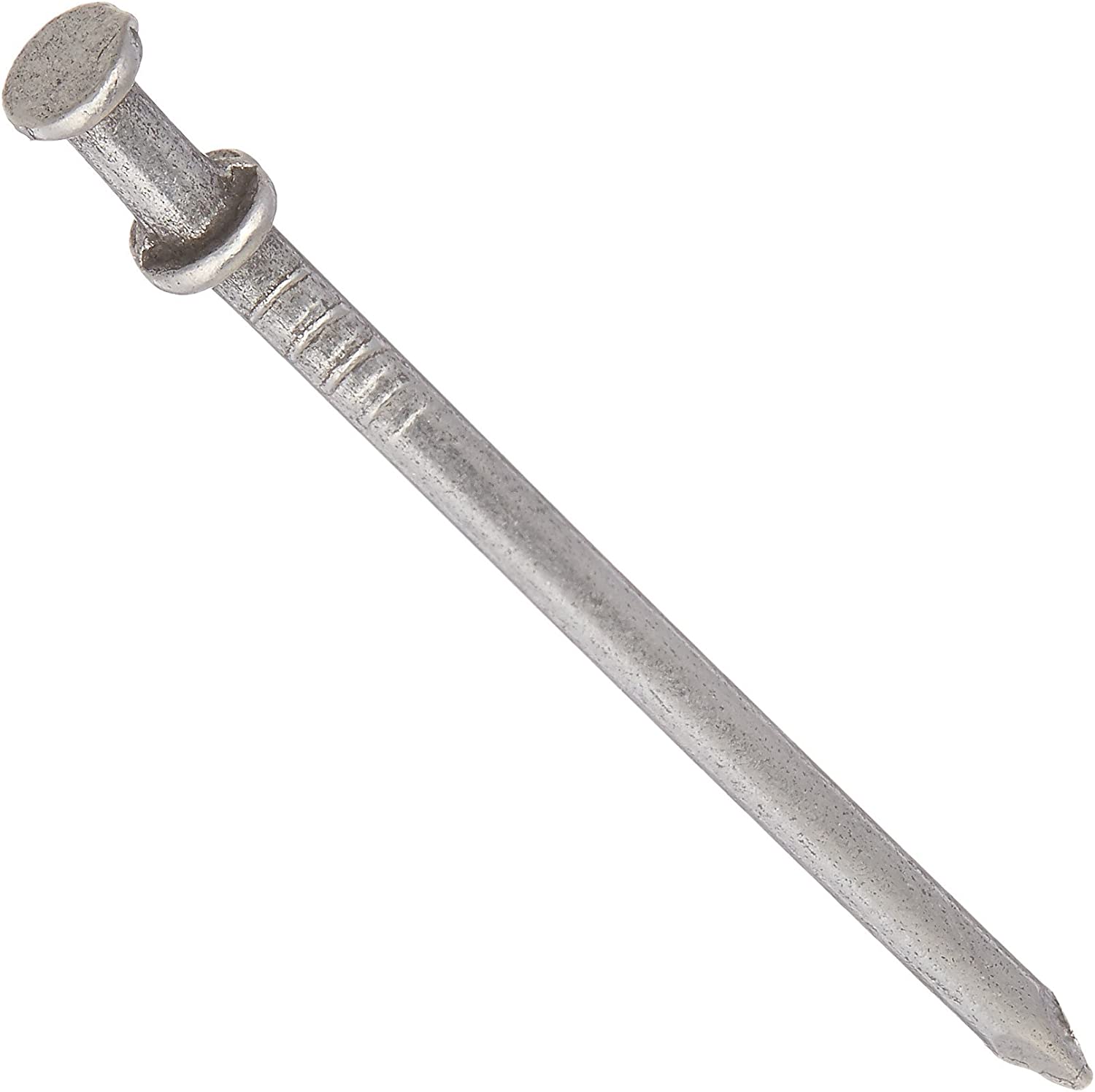
The duplex nail is a variation of the common nail. It features a second head along the shaft which allows the duplex nail to be used for temporary construction (like scaffolding and staging); after it is driven snug, it can still be easily removed.
Best For: Scaffolding, staging, and other temporary structures
RELATED: Buyer’s Guide: The Best Hammers We Tested This Year
4. Framing Nail
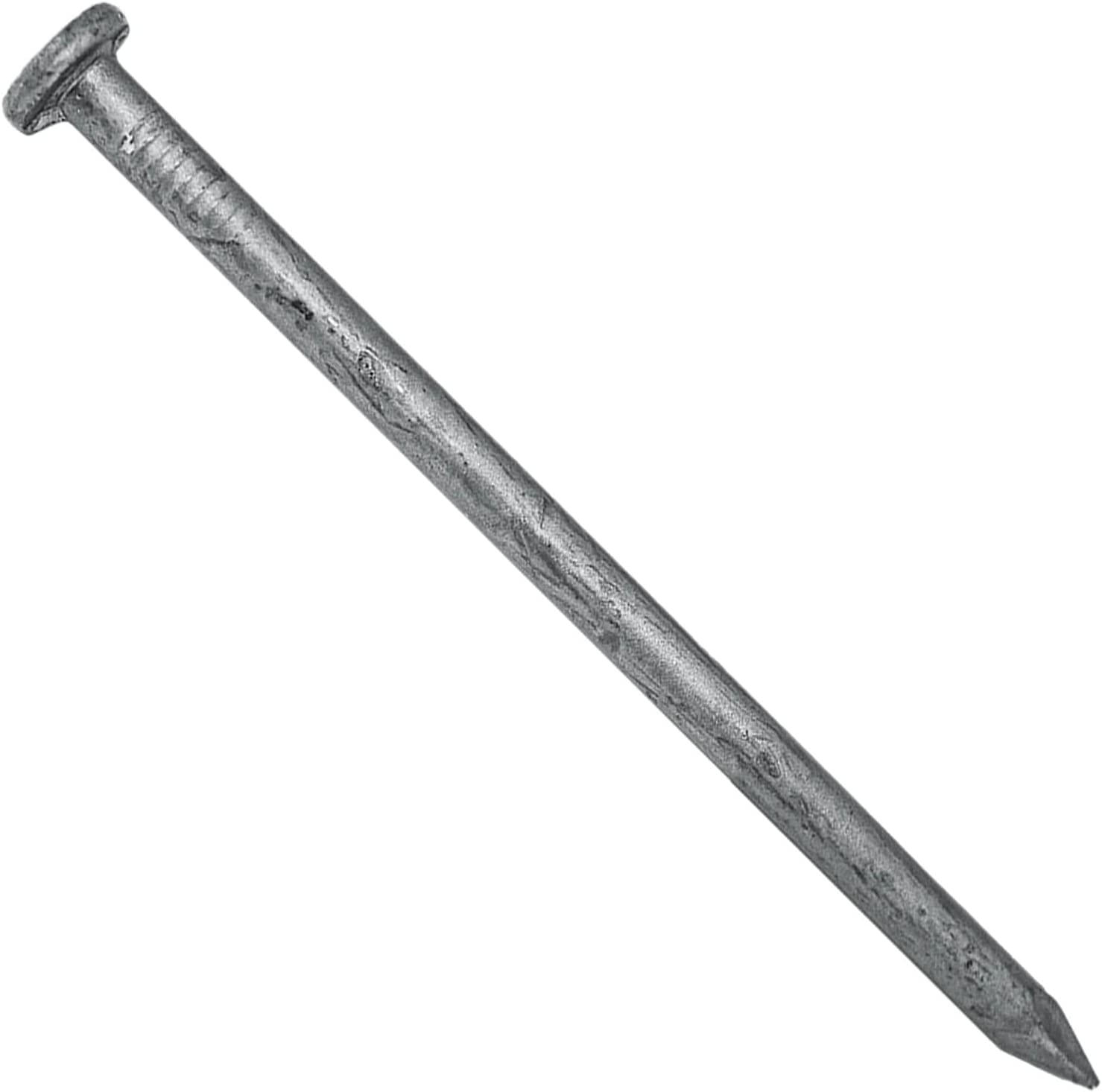
Framing nails are essentially the same as common nails, and they are the general construction nails many are used to seeing. They have thick shanks, wide heads, and provide a lot of holding power and strength. They come in a bright finish for indoor projects and galvanized for outdoor projects. They’re also available in many sizes.
Best For: Framing and general construction work
RELATED: Buyer’s Guide: The Best Framing Nailers
5. Deck Nail
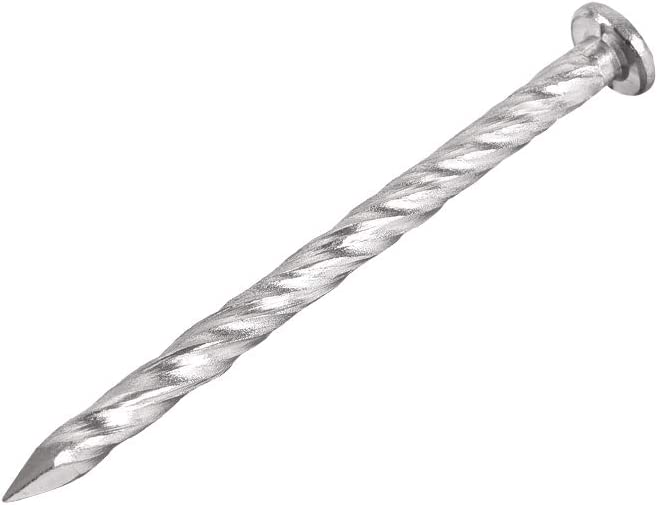
Deck nails are not a specific type of nail, but any nail used to attach exterior decking material to a frame. They’re usually just galvanized framing nails, and they’re the fastest, easiest, and cheapest way to build decks, though they have a tendency to back out of the framing over time.
Best For: Installing deck boards to a subframe
Specialty Nails
6. Finishing Nail
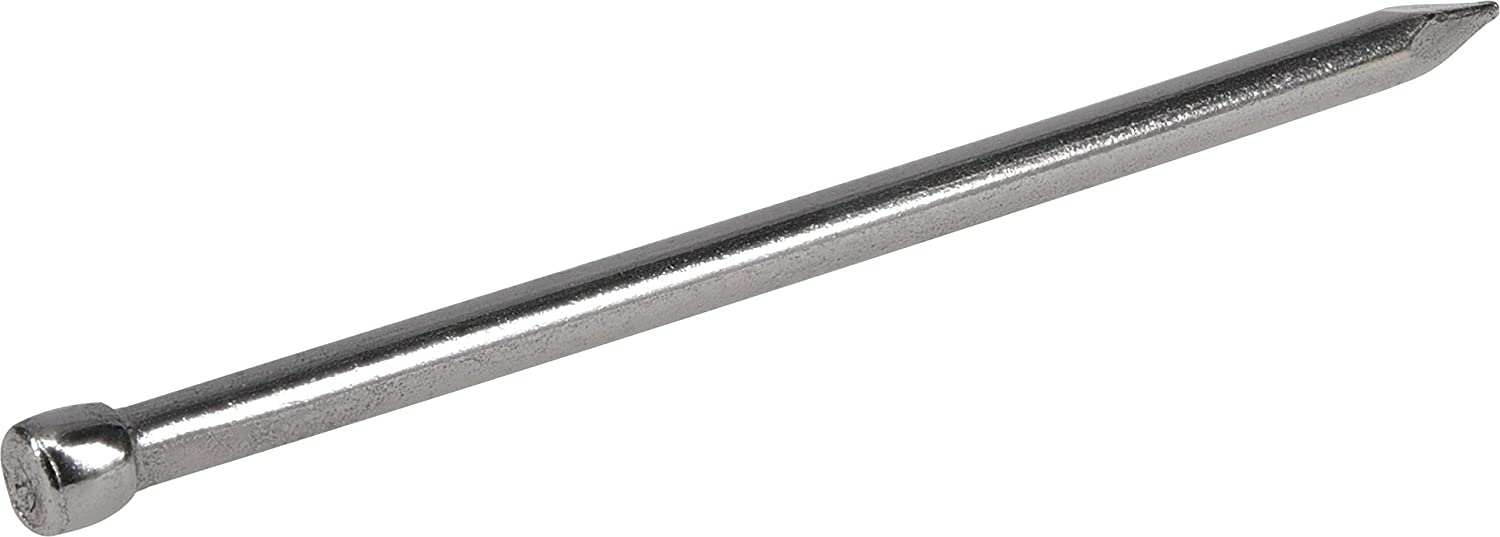
Finishing nails are (surprise, surprise) used for finish work. Their barrel-shaped heads are small and can be driven below the surface of the wood using a nail set (a technique called countersinking). Finishing nails are useful for installing trim, crafting furniture, and building other projects where you want to hide the head of the fastener.
Best For: Trim, moldings, and other finish work
RELATED: Buyer’s Guide: The Best Finish Nailers
7. Casing Nail
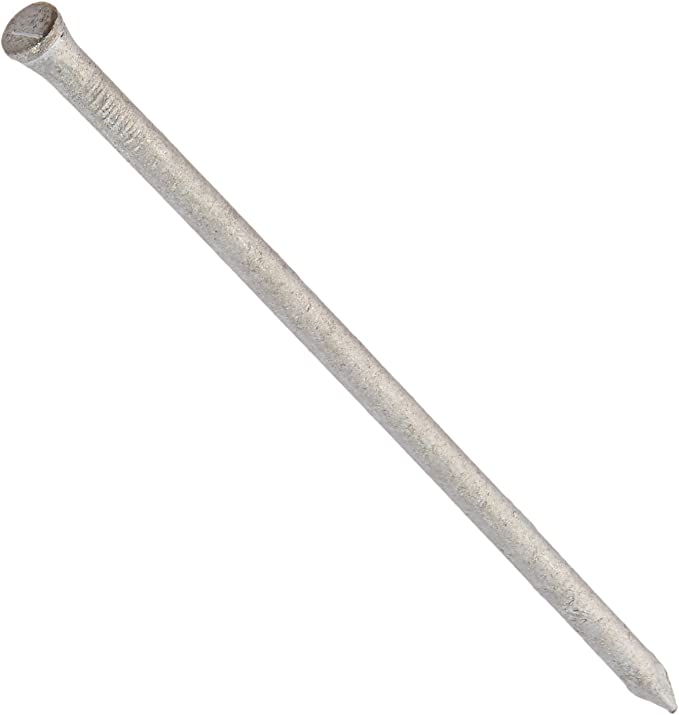
A close cousin of the finishing nail, the casing nail is slightly larger and has increased holding power. It is commonly used for attaching moldings such as window and door casings (often outdoors) where added strength is needed.
Best For: Attaching window and door casing as well as other heavy trim
8. Brads
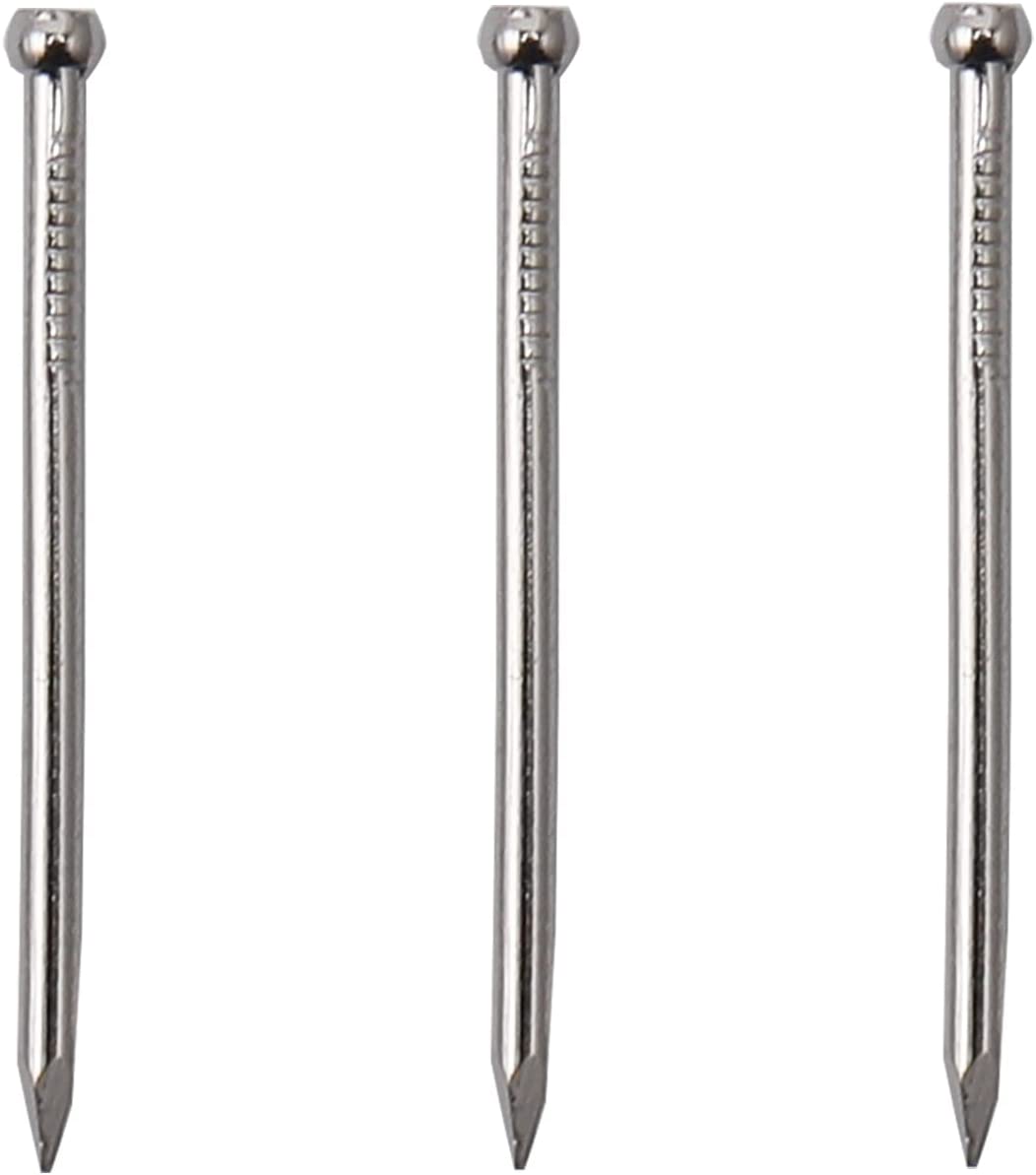
Brads are used as finishing nails but are proportionately smaller in diameter, with smaller heads. Brads are used in building frames, attaching plywood paneling, some moldings, and in cabinet work. Their slightly thinner diameter and smaller heads make them less likely to split wood, and easier to hide.
Best For: Building frames, attaching paneling, moldings, and some cabinet work
RELATED: Buyer’s Guide: The Best Brad Nailers We Tested This Year
9. Cut Flooring Nail
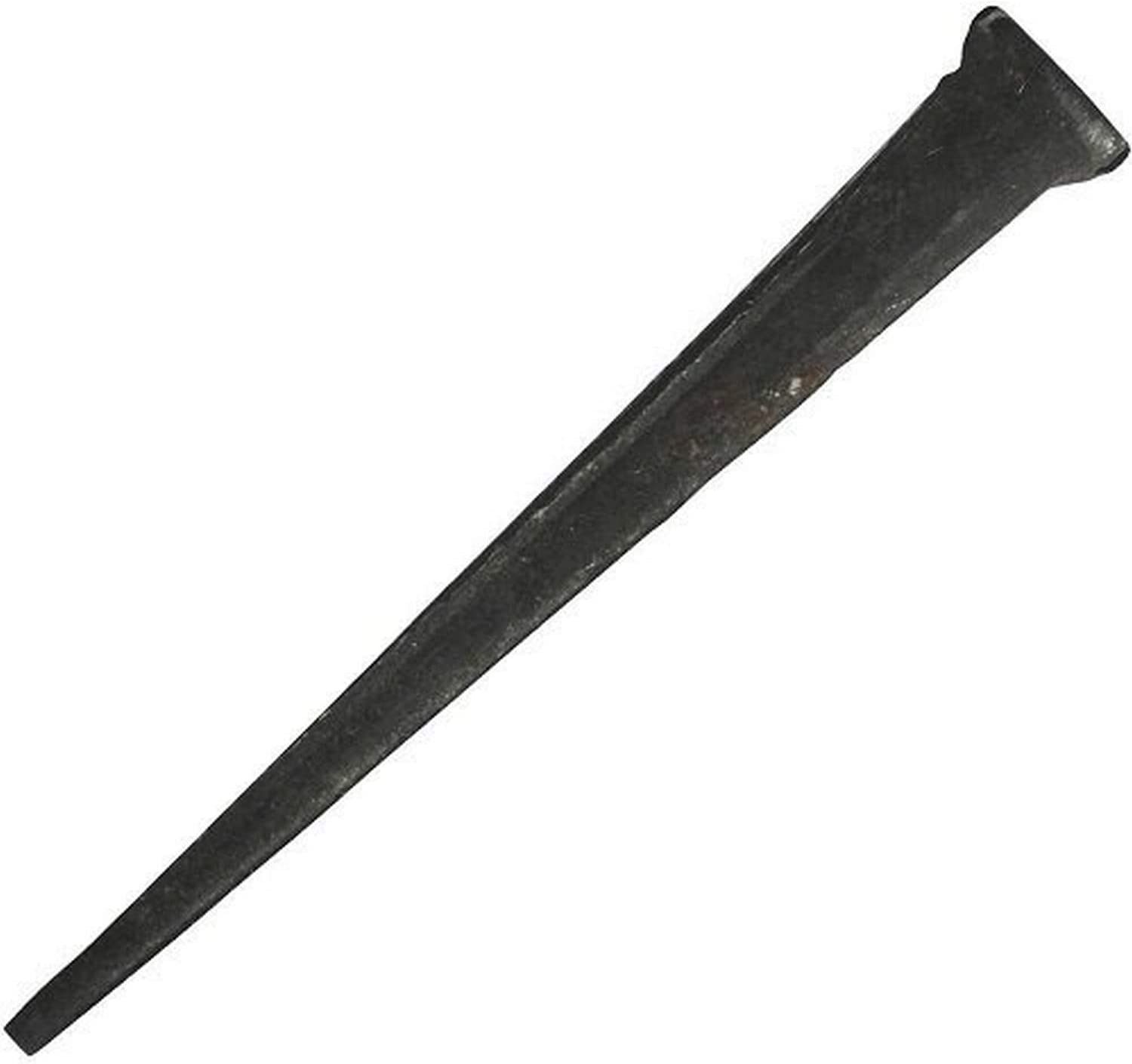
The cut nail is used for installing flooring. These nails are large and strong, with four flat sides and a tapered wedge design. They were extremely common before wire nails took their place, and today they’re hand-nailed into flooring and other projects for a vintage look.
Best For: Flooring and other projects that require a vintage look
RELATED: Cut Nails: Hammering Home Authenticity
10. Landscape Spikes
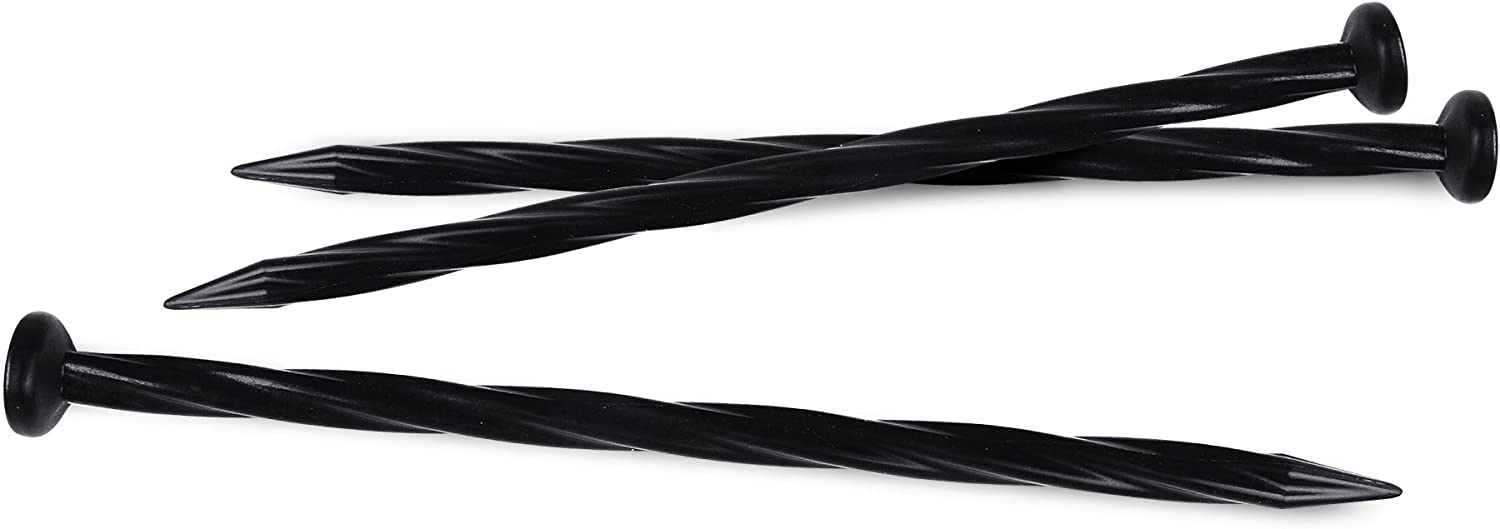
Landscape spikes aren’t traditional nails, though they can be useful for connecting landscape timbers. Instead, they hold landscape items such as edging or flower beds in place. The user drives them into the ground, where their long length and textured shanks prevent them from backing out easily.
They come in galvanized varieties, but they’re also available in plastic. Both materials are resistant to the elements, making them ideal for driving into the ground and burying with topsoil or mulch.
Best For: Landscape edging, flower bed construction, and other outdoor applications (tent poles, tarp anchoring, etc.)
11. Sinker Nail
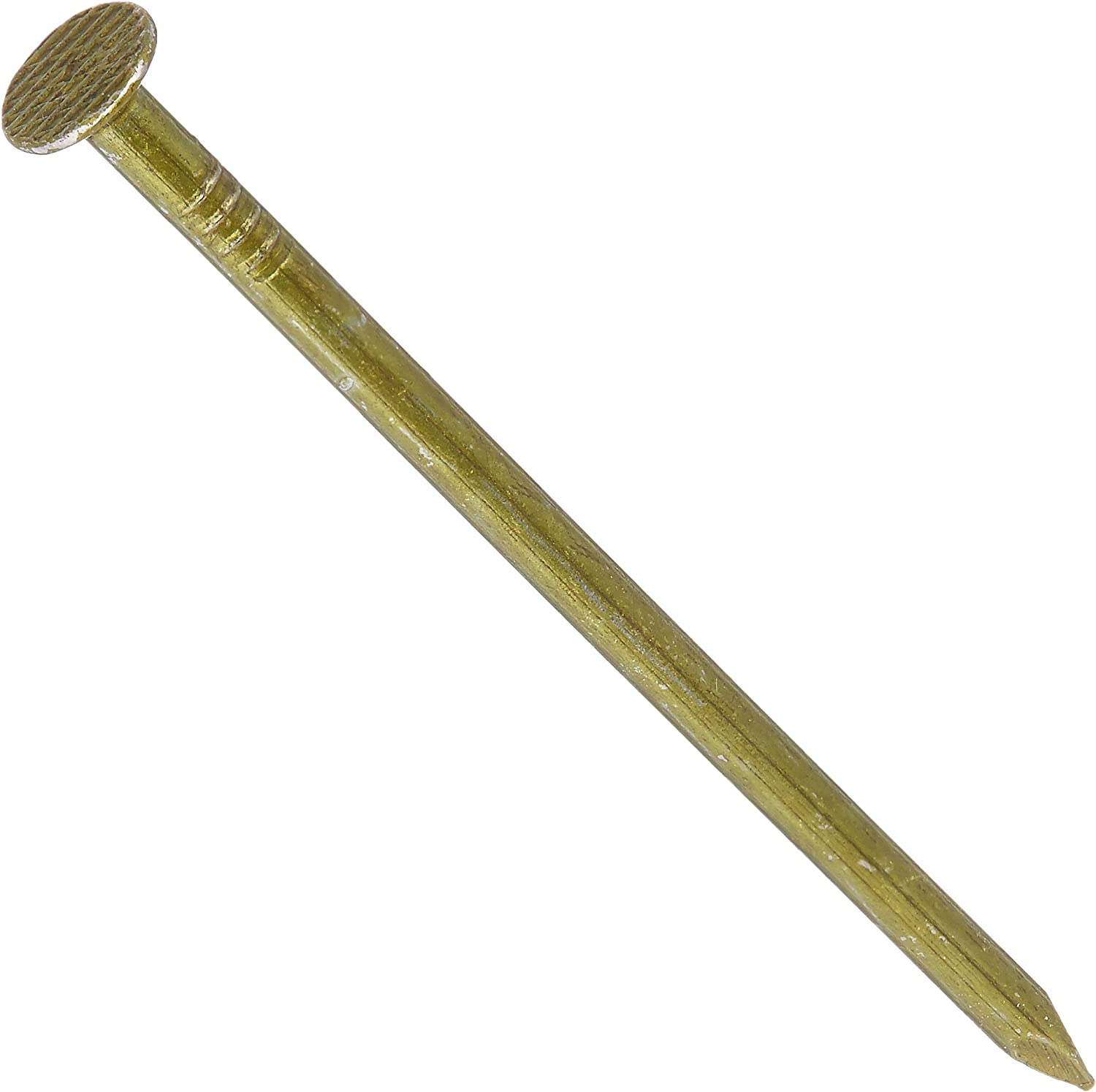
A sinker nail is a variety of the framing nail. They may be just slightly thinner than a framing or common nail, but they have a light coating on their shank to make them easier to drive into framing materials. While hand-nailing framed walls is less common today, sinkers can increase speed and efficiency.
Best For: Framing, particularly in a production environment
RELATED: Buyer’s Guide: The Best Nail Guns for Fencing
12. Joist Hanger Nail
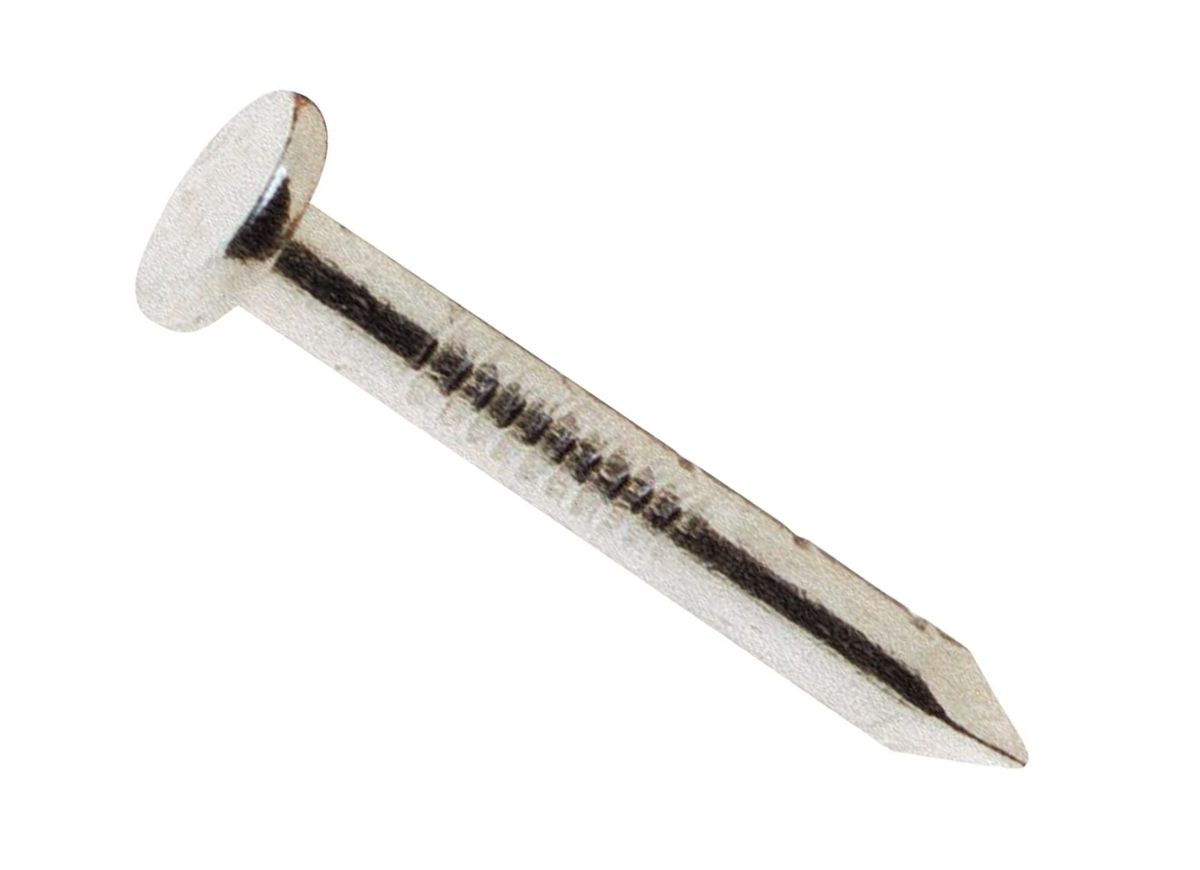
Hanger nails are stubby galvanized nails used to attach joist hangers to ledgers. They don’t have to be long because they simply pinch the joist hanger (which is under 1/8-inch thick) to the ledger, and then the joist to the joist hanger. They may also be used to attach stair stringers, hurricane ties, strapping, and other galvanized brackets. Joist hanger nails provide much more holding and sheer strength than nailing into the end of the joist.
Best For: Attaching joist hangers, stringer hangers, hurricane ties, and strapping on outdoor decks
13. Pole Barn Nail

Pole barn nails are long, thick nails that often feature textured shanks and galvanized dipping. Their traditional use is attaching heavy timbers to each other in pole barn construction. Their improved strength allows them to carry more force, a necessary trait in a barn built with fewer framing members and fasteners than traditional framing. They may also be ideal for building wood retaining walls and spiking landscape edging to the ground.
Best For: Pole barns and heavy-duty outdoor construction applications
14. Connector Nail
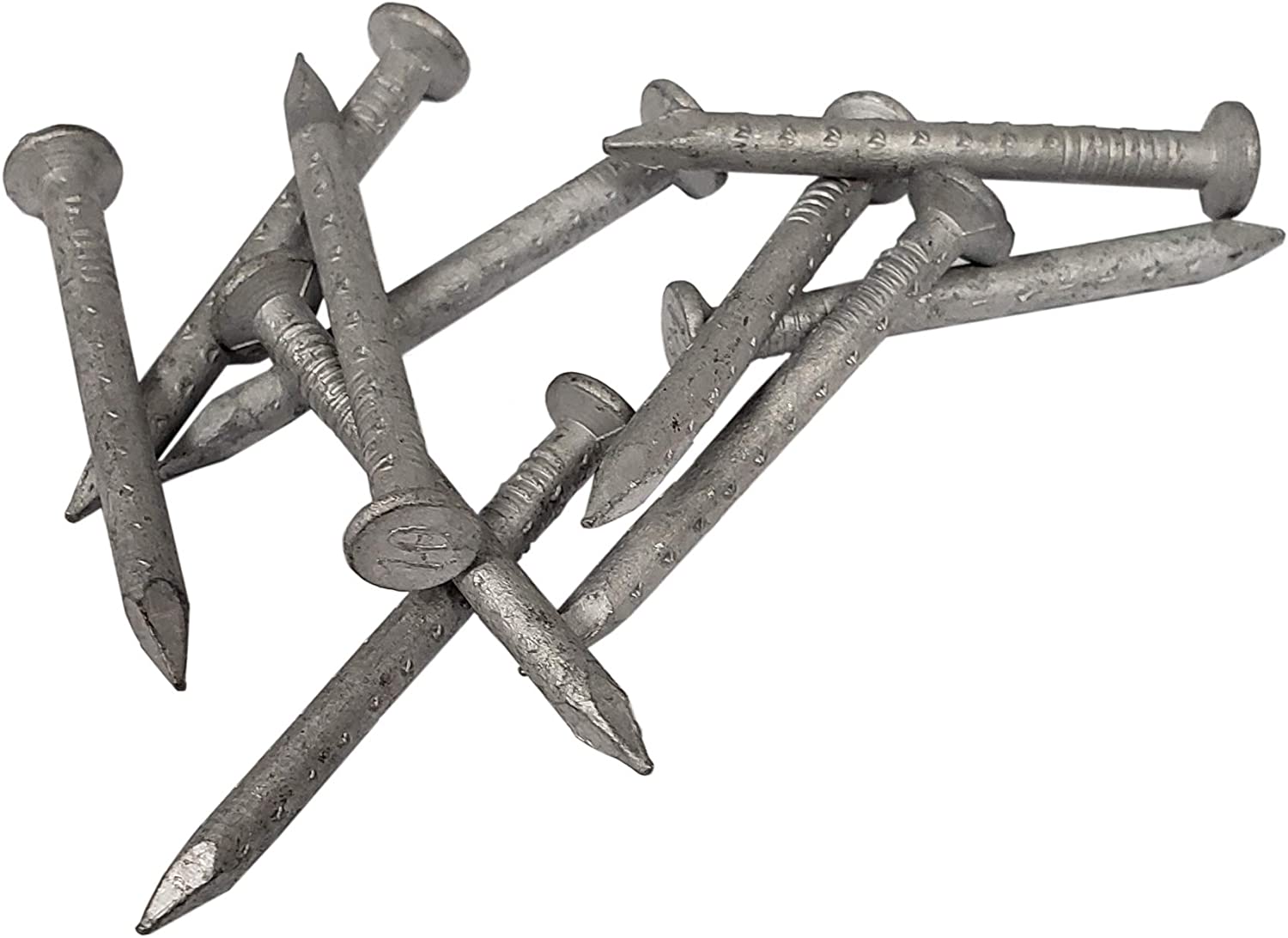
“Connector nail” is another name for a joist hanger nail. These nails are short, thick, and galvanized, and they’re used to attach hurricane ties, joist hangers, strapping, and other thin metal reinforcements to outdoor framing materials.
Best For: Attaching joist hangers, hurricane ties, and strapping to exterior wood framing
15. Trim Nail
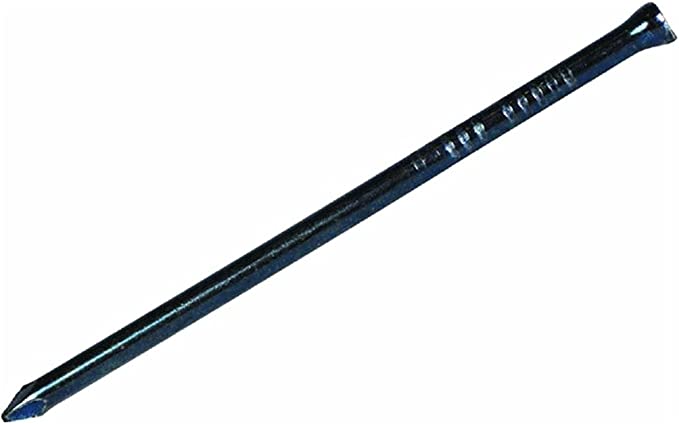
“Trim nail” is another term used to describe finish nails. They have cupped heads, a bright finish, and thin shanks, and they’re used to install larger moldings to walls and ceilings.
Best For: Installing trim and moldings to walls and ceilings
RELATED: Brad Nailer vs. Finish Nailer: What’s the Difference?
16. Pin Nail
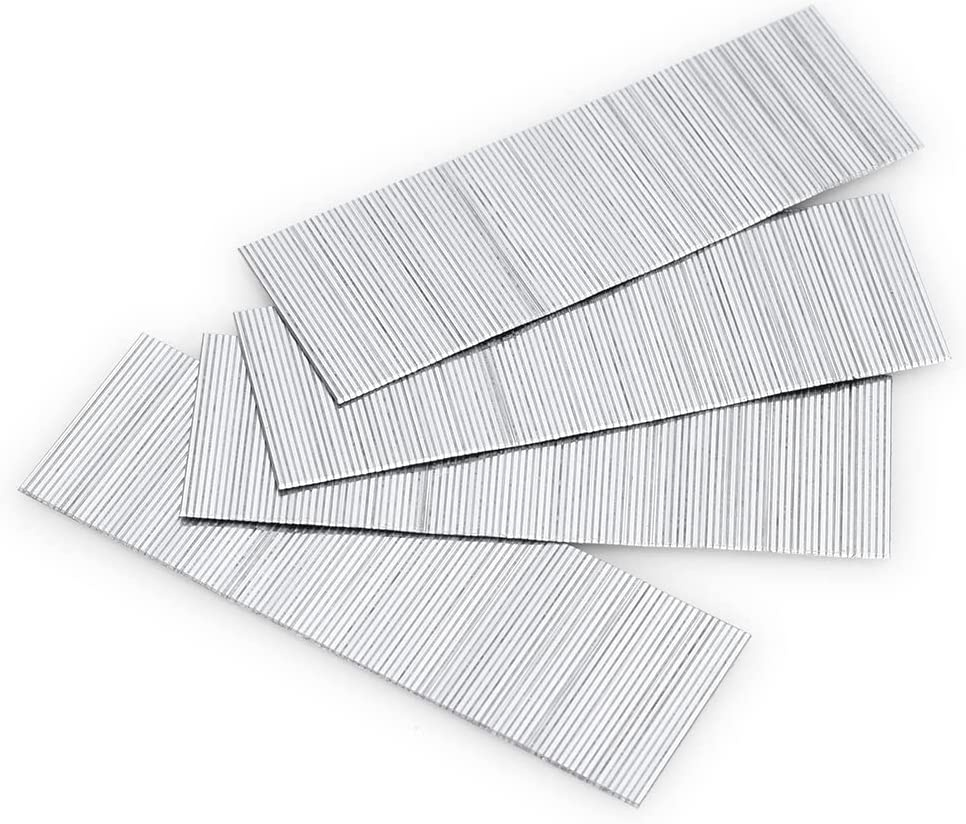
Pin nails are small wire nails without heads. They’re extremely thin, can only be fired from a pin nailer, and don’t offer much holding strength. However, their thin design and lack of a head make them almost invisible once fired and they hardly ever split wood. This makes pin nails a popular choice for picture framing, attaching delicate moldings such as thin beads or rope patterns, as well as fastening thin cornice moldings to cabinets.
Best For: Building picture frame, attaching delicate moldings, and installing cornice molding to cabinets
17. Spiral Shank Nail
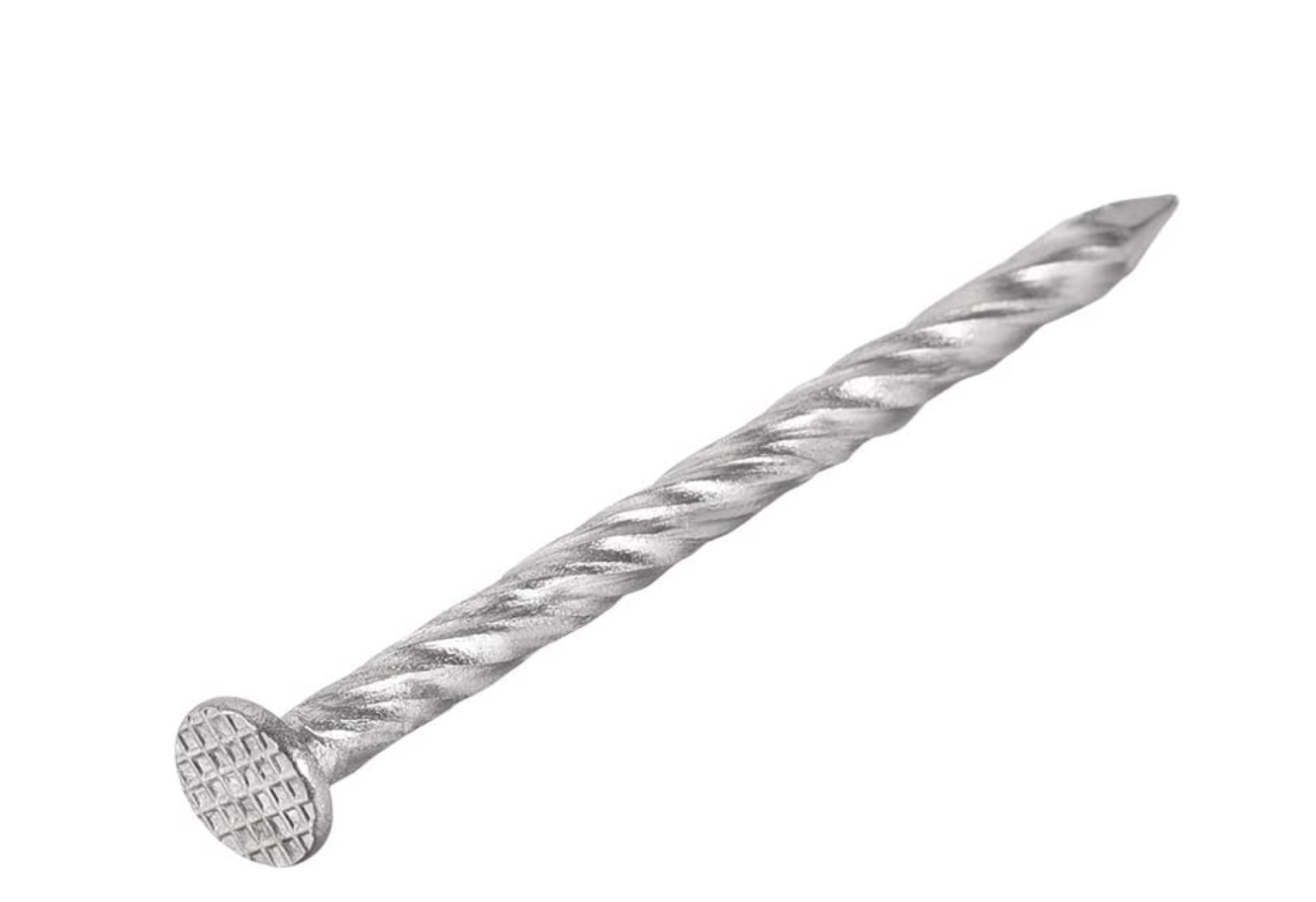
Spiral shank nails include several types of nails with twisted shanks. They’re difficult to drive, but these nails twist as they enter the wood, creating a screw-like effect that increases their holding strength. In framing applications, they may be required in high-wind zones and some types of subfloor systems.
Best For: Framing in high-wind zones, and when assembly certain subfloor systems
Material-Specific Nails
18. Roofing Nail
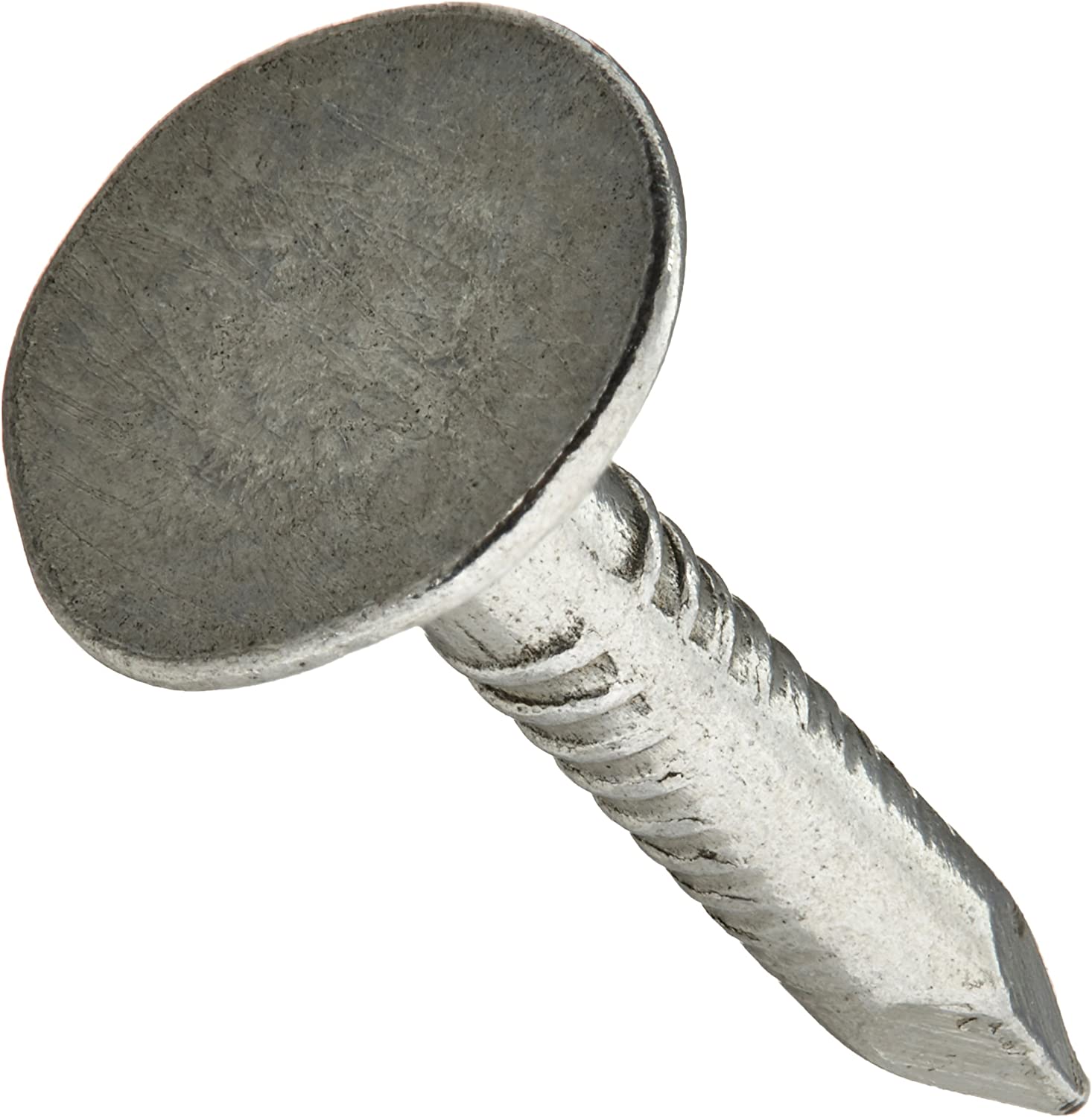
Roofing nails have disproportionately large, round heads and heavier shanks than many other nails. Designed to hold composite and asphalt roofing materials in place without tearing, roofing nails are heavily galvanized to resist rust.
Best For: Fastening shingle tabs to roof decks
RELATED: 6 Types of Shingles and the Pros and Cons of Each
19. Masonry Nail
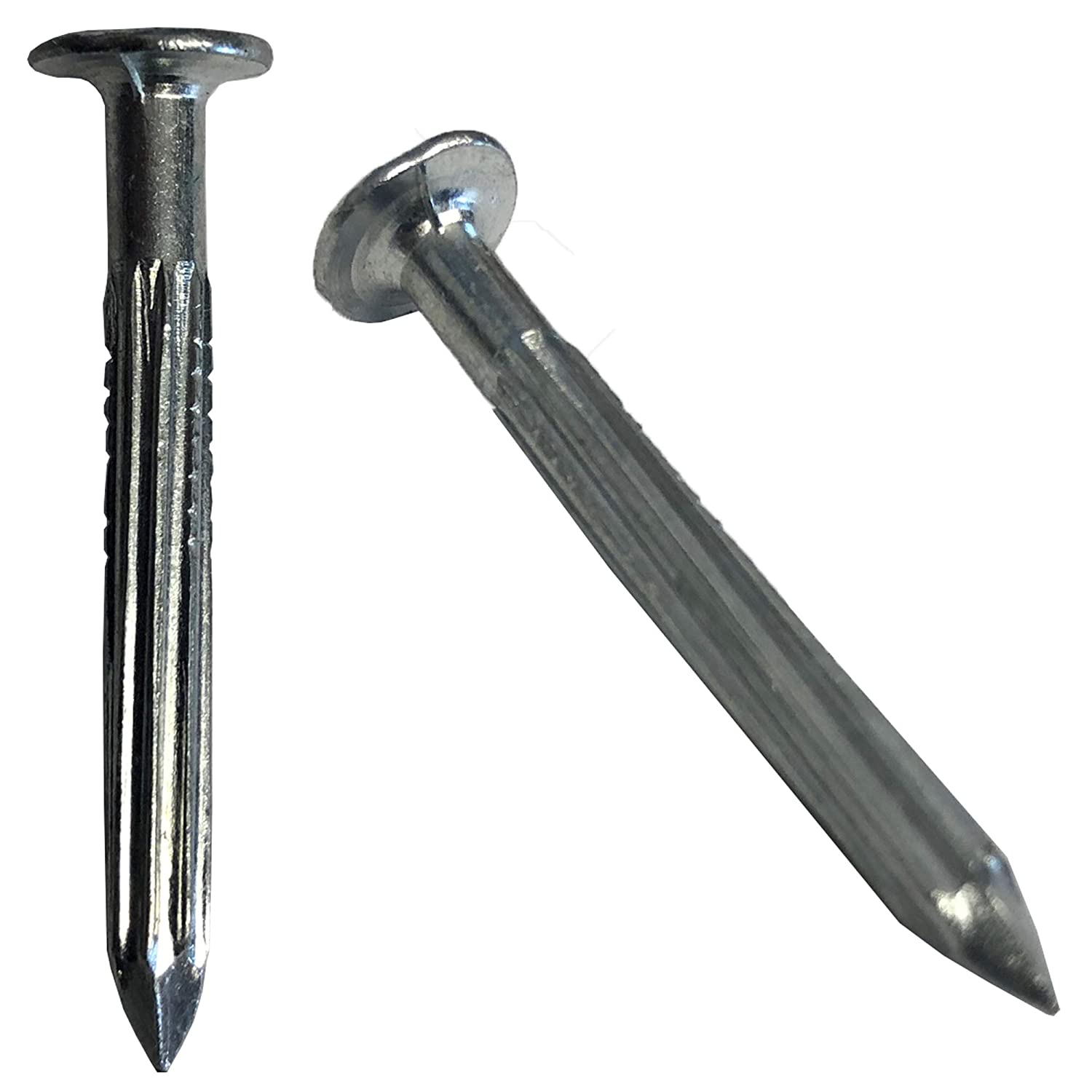
There are several types of masonry nails available; all are designed to be driven into brick or concrete walls. The shape of the masonry nail varies by type, but all are hardened to resist bending and breaking as they are driven into almost rock-hard materials. They can be used to attach wood framing to a concrete slab, hang pictures from a brick wall, or attach furring strips for drywalling over a masonry surface. Be sure to wear safety glasses when using masonry nails, as flying concrete or masonry chips or errant nails could harm your eyes.
Best For: Hanging pictures, or attaching items and wood frames to concrete and brick surfaces
20. Annular Ring Nail
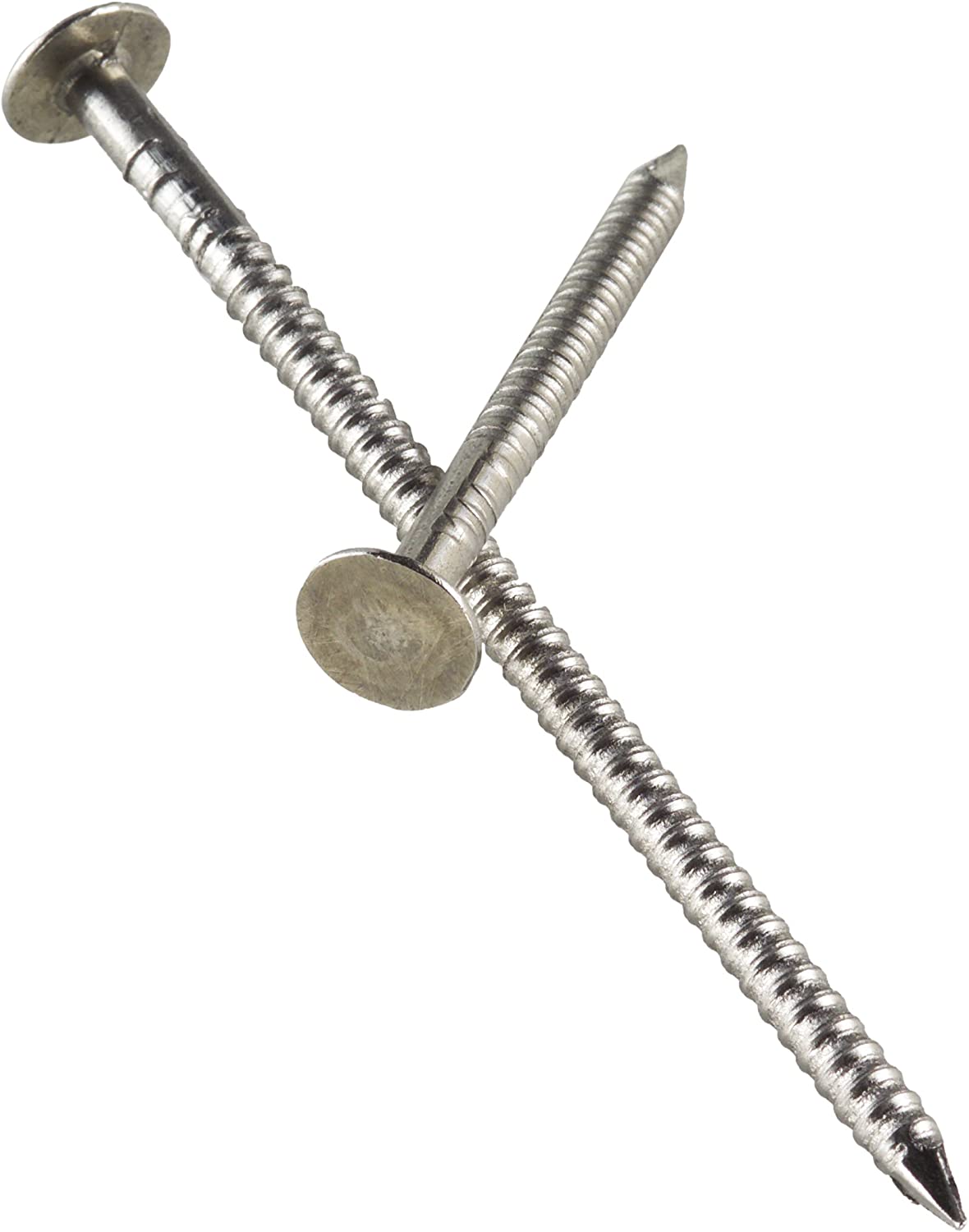
Often made of galvanized steel, annular ring nails are commonly used to hold clapboards or shingles in place on home exteriors. These thin nails, lined with rings for added holding power, are resistant to rust.
Best For: Attaching siding and shingles to homes, as the rings on the shank increase holding power
21. Drywall Nail
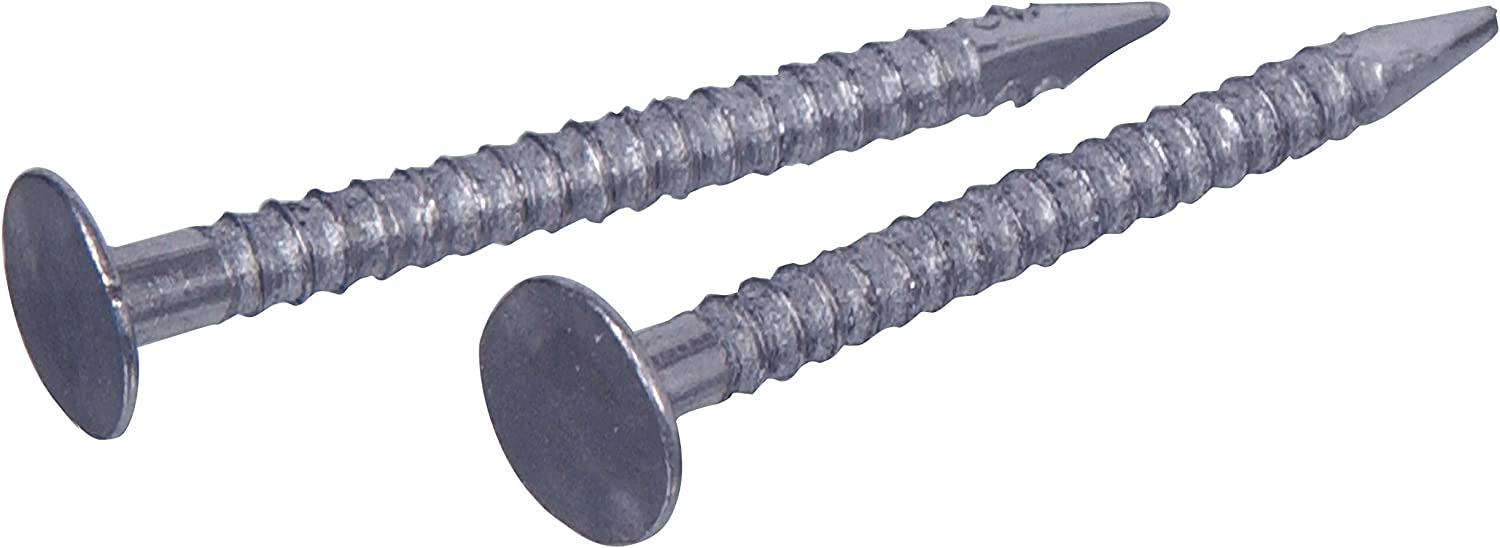
Drywall nails are thin-shanked, have wide heads and, as the name implies, are used for installing drywall over wood framing. These wood nails are designed this way so they may penetrate the drywall and wood framing behind it, yet spread the holding power over a wider surface area (under the head). They’re coated with black phosphate to improve adhesion with drywall mud and paint, as well.
Note: These are the nails that sometimes appear to pop through a finished drywall surface. This occurs for many reasons, and it’s important to repair the nail pops.
Best For: Installing drywall to wood framing underneath
RELATED: The Dos and Don’ts of Repairing Drywall
22. Siding Nail
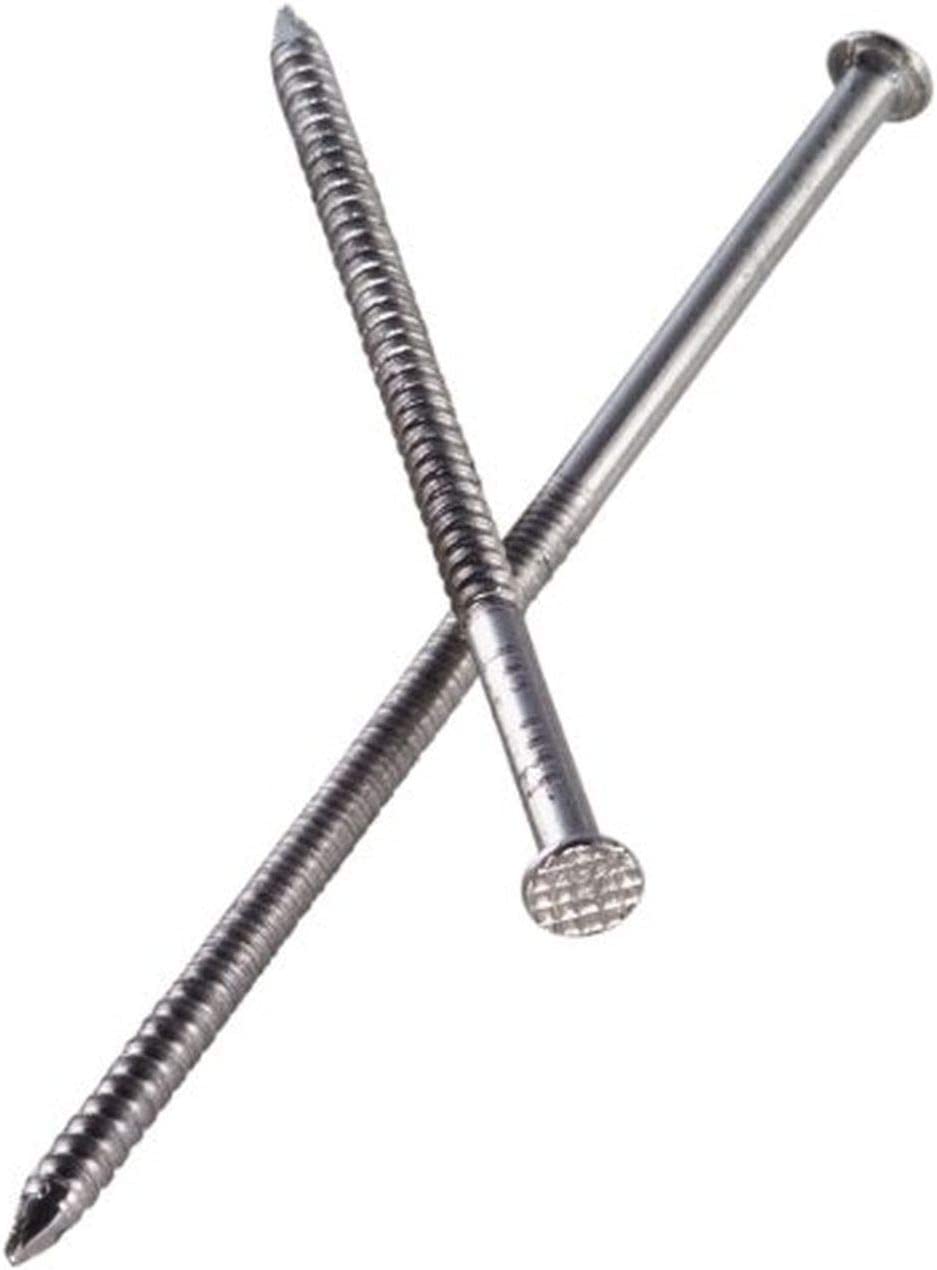
There are a couple of types of siding nails, including the annular ring shank nail described above, and those with spiral shanks. These nails have thin shanks (with a ring or spiral) and wide heads. Siding nails used to nail through the face of clapboard will have exposed heads, so it’s best to use galvanized siding nails in these cases. The exception would be if the clapboard is cedar, which would require stainless steel nails.
Best For: Hanging siding and clapboard
23. Cap Nail
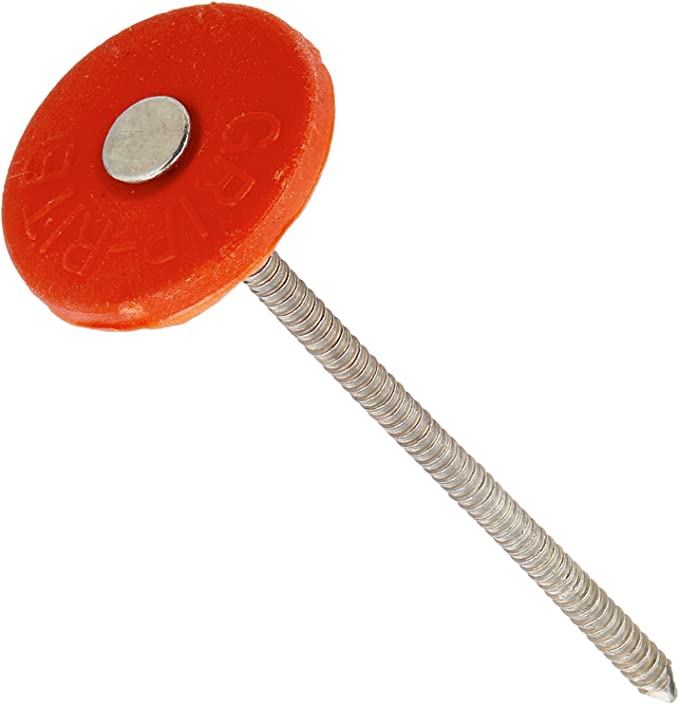
Cap nails are a combination of a plastic washer and an annular ring shank nail. They’re used for installing roofing underlayment, tar paper, house wrap, and fanfold to a wood structure underneath. The nail slides through the center of the washer, drives into the wood structure, and loosely holds the material in place to prevent the head from ripping through the material.
Best For: Attaching roofing underlayment, tar paper, house wrap, and fanfold to wood structures
24. Panel Board Nail
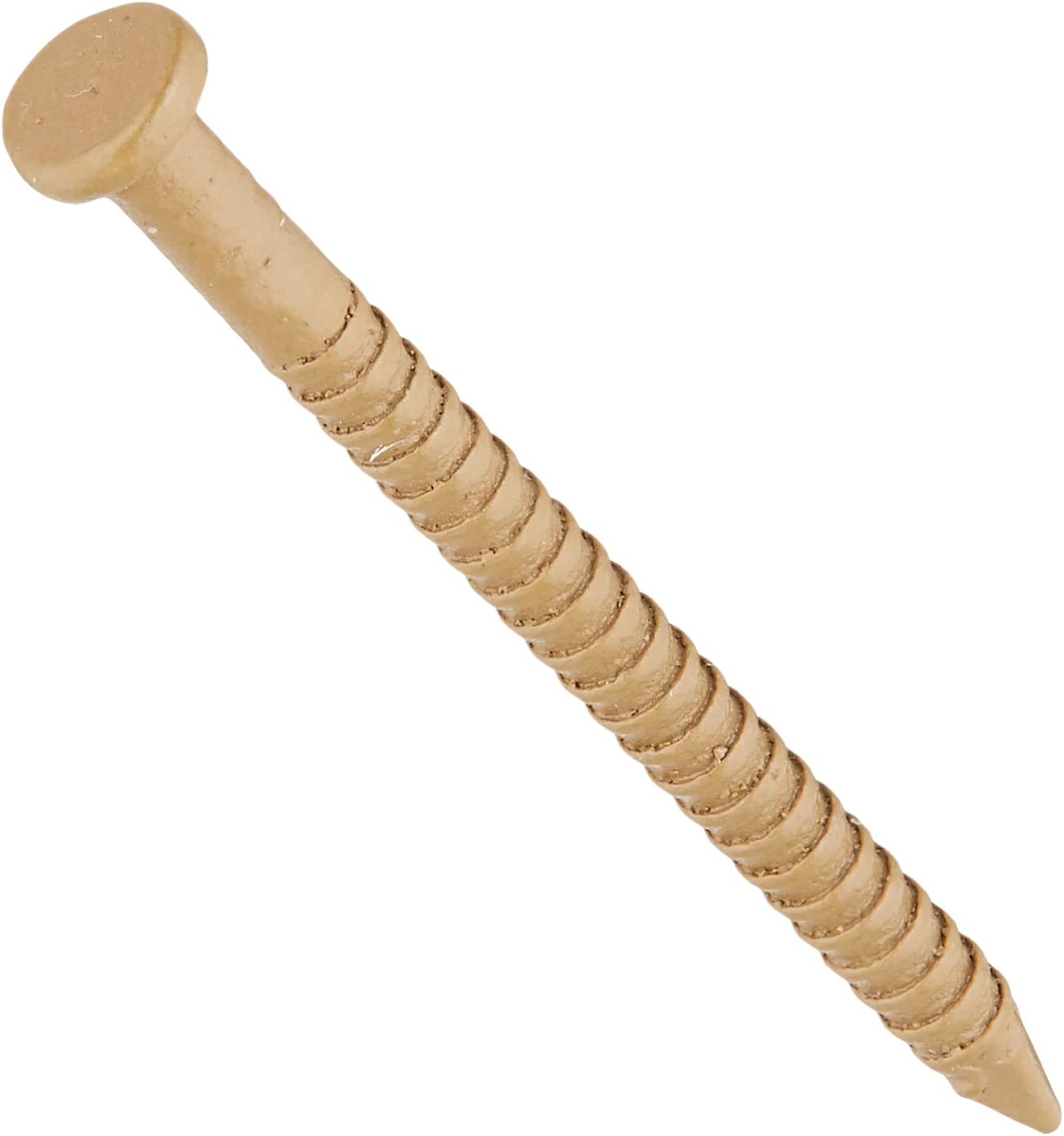
Panel board nails are a variation of the annular ring shank nail, but they’re typically smaller and thinner. Their common use is to attach sheets of hardboard, such as beadboard paneling, to wood studs and furring strips. They’re small but provide plenty of holding strength when used together. They’re also available pre-painted to blend in better with panel finishes.
Best For: Attaching hardboard paneling to wood framing and furring strips
RELATED: 19 Drywall Alternatives You’ll Wish You Knew About Sooner
25. Furniture Nail
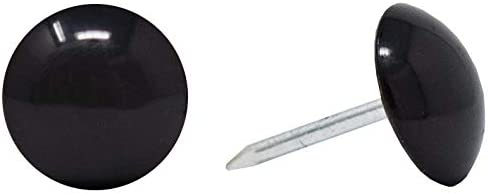
Furniture nails are decorative fasteners used for attaching (or give the appearance of attaching) upholstery to wooden furniture. They have thin shanks, wide heads, and often come in a variety of materials and finishes.
Best For: Decorative attachment of upholstery to wooden furniture
Tips for Using Nails
The following are some helpful tips to consider when fastening with nails:
- When driving small nails, avoid hitting fingers with a hammer by punching the nail through a small scrap of cardboard, holding the nail in place with the cardboard, and then driving it in with a hammer.
- Pointed nail tips act like a wedge and split wood. Consider blunting the end of a nail by turning it over and tapping the point with a hammer. The blunted tip will punch the wood fibers through the board rather than wedging them apart.
- When toe-nailing (a nailing technique used to drive nails at an angle), start the nail at a 90-degree angle to the board. Once the tip of the nail is about ⅛-inch into the board, adjust the nail to a 45 degree angle to the board and continue to drive it with the hammer.
- Certain wood species, such as cedar or redwood, will react with bright nails, even in interior applications. Stainless steel, hot-dipped galvanized, or aluminum nails are better in these instances.
- Driving a large nail with a light hammer will often result in bending the nail. Instead, use an appropriately sized and type of hammer: 12 ounces for light work and small nails, 16 ounces for general work, and 20 ounces or more for framing.
Shop for nails at Lowe’s
Shop for nails at The Home Depot
Shop for nails at Ace Hardware
Shop for nails at Amazon


